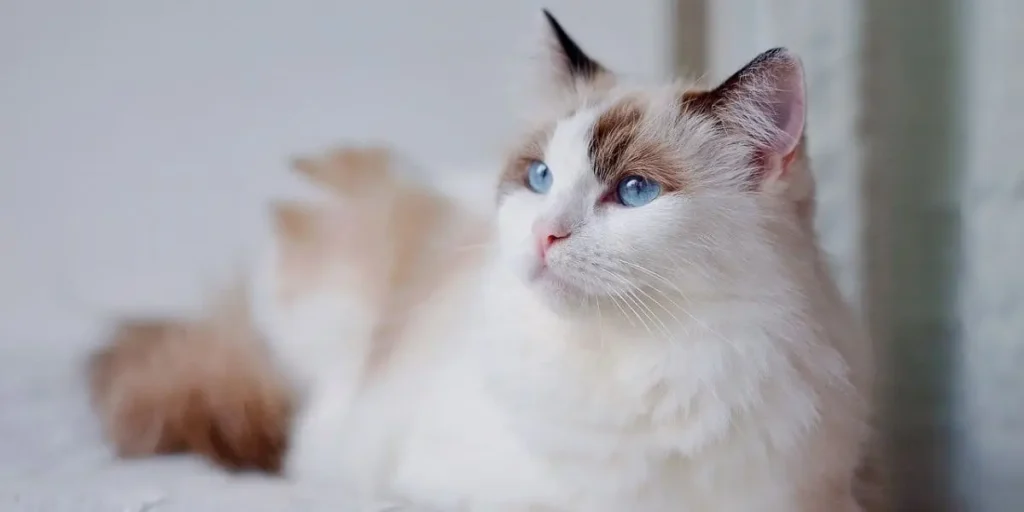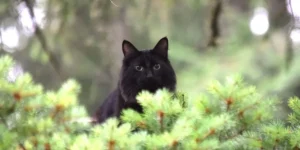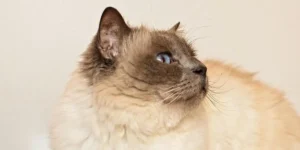Table of contents
History of the Breed
The Ragdoll breed was created by Ann Baker, a Persian cat breeder in Riverside, California, in the early 1960s. She developed it by crossing a Persian Angora female with a Sacred Birman male, producing a cat with an exceptionally gentle temperament. She named the new breed Ragdoll, which literally means rag doll.
Ann Baker registered several Ragdolls with the National Cat Fanciers’ Association. She also gave some cats to Denny and Laura Dayton, who played a key role in developing the breed through their famous Blossom Time cattery until the 1980s, despite distancing themselves from Baker.
The Ragdoll gained major popularity in the US and began receiving recognition from major feline organizations in the 1970s, including The International Cat Association (TICA).
Exports soon followed, first to the UK, then to Europe. In France, the first Ragdolls arrived in 1986 thanks to Noëlle Vialatte (Gailande cattery, Pyrénées-Atlantiques) who imported Barfield and Blossom of Patriarca. Their first litter was born two years later. The breed has steadily grown in popularity, with the LOOF (Livre Officiel des Origines Félines) recording over 2,700 registrations in 2019, compared to only 76 in 2003.
Physical Characteristics
Body: Strong, heavy, and long, with a rectangular shape. The neck is short and muscular, the chest is broad and rounded, and the medium legs have strong bones.
Coat: Medium-long, silky, with a dense topcoat and moderate undercoat. Shorter on the front legs, longer and denser on the hind legs. The ruff is especially prized.
Color: Four main patterns – colorpoint, mitted, bicolor, and van. The body is usually off-white to creamy white. Colorpoints have darker ears, mask, legs, and tail. Mitted cats have a white chin with a stripe down the chest and belly, darker ears, mask, and legs. Bicolors feature a pink nose and a white inverted V on the mask. Vans are mostly white with darker ears, tail, and upper mask.
- Head: Triangular, rounded contours, rounded skull and forehead. Medium, well-developed muzzle and strong chin.
- Eyes: Large, oval, slightly slanted, always a vivid blue.
- Ears: Medium-sized, broad at the base, extending the triangular head, tilted forward, with rounded tips.
- Tail: Long, broad at the base, well furnished with hair.
Temperament and Personality
The Ragdoll’s legendary gentleness is one of its defining traits. It shows no signs of aggression and is known for its patience, making it an excellent companion for children. Calm and discreet, it seeks tranquility and dislikes noisy environments.
Ragdolls do not tolerate solitude well and prefer to stay close to their owners. They are affectionate, love cuddling, sitting on laps, and even being held in arms. Ragdolls are mainly indoor cats, preferring the safety and comfort of home.
Living Conditions
Thanks to its calm nature, the Ragdoll adapts to most family structures and environments. However, it is much more suited to indoor living than exploring outdoors. It should be kept safe, as it is not skilled at defending itself even against other cats. Apartment life is perfectly suitable for this breed.
Health
The Ragdoll is generally healthy but can be affected by two common feline diseases: HCM and PKD.
HCM (Hypertrophic Cardiomyopathy) is a heart disease seen in both mixed and pedigree cats, often affecting young adults around two years old. It may cause acute congestive heart failure symptoms, including pulmonary edema, pleural effusion, and arrhythmia. A DNA test exists for HCM.
PKD (Polycystic Kidney Disease) is a renal disorder characterized by cysts in the kidneys, leading to renal failure.
- Hypoallergenic breed: No
Life Expectancy
The average life expectancy of a Ragdoll is between 12 and 17 years.
Grooming and Hygiene
With a medium-length coat and moderate undercoat, Ragdolls are not overly demanding in grooming. Brushing once or twice a week keeps their fur healthy and prevents hairballs. Special attention should be given to the pants area (hindquarters) where fur is thicker. Occasional baths may be needed. Regular dental care is essential to prevent tartar buildup, and claws should be trimmed regularly since they wear down slowly.
Price and Budget
| Category | Minimum | Maximum |
| Purchase Price | €600 | €2500 |
| Annual Care Costs | €500 | €800 |
Diet
Because Ragdolls are less active than many cats, they can gain weight easily. Their diet should be low in carbohydrates and fats, with high-quality protein and balanced nutrients. Premium dry food, such as Hill’s, is recommended to meet nutritional needs and maintain dental health. Fresh water must always be available.
| Breed | Ragdoll |
| Origin | United States |
| Coat Type | Semi-long, silky |
| Shedding | Moderate |
| Weight (Female) | 3–6 kg (6.5–13 lbs) |
| Weight (Male) | 4–9 kg (9–20 lbs) |
| Life Expectancy | 12–17 years |
| Hypoallergenic | No |


